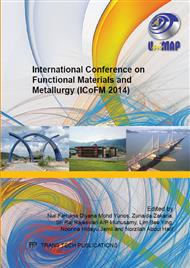[1]
Y. Fujii, H. Miura, N. Suzuki, T. Shoji, N. Nakayama, Structural and electrochemical properties of LiNi1/3Mn1/3Co1/3O2: Calcination temperature dependence, Journal of Power Sources 171 (2007) 894-903.
DOI: 10.1016/j.jpowsour.2007.06.017
Google Scholar
[2]
T. Ohzuku, Y. Makimura, Layered lithium insertion material of LiCo1/3Ni1/3Mn1/3O2 for lithium-ion batteries, Chemistry Letters 30 (2001) 642-643.
DOI: 10.1149/ma2005-02/4/107
Google Scholar
[3]
N. Yabuuchi, T. Ohzuku, Novel lithium insertion material of LiCo1/3Ni1/3Mn1/3O2 for advanced lithium-ion batteries, Journal of Power Sources 119 (2003) 171-174.
DOI: 10.1016/s0378-7753(03)00173-3
Google Scholar
[4]
D. C. Li, T. Muta, L. Q. Zhang, M. Yoshio, H. Noguchi, Effect of synthesis method on the electrochemical performance of LiNi1/3Mn1/3Co1/3O2, Journal of Power Sources 132 (2004) 150-155.
DOI: 10.1016/j.jpowsour.2004.01.016
Google Scholar
[5]
E. Shinova, R. Stoyanova, E. Zhecheva, G. R. Ortiz, P. Lavela, J. L. Tirado, Cation distribution and electrochemical performance of LiNi1/3Mn1/3Co1/3O2 electrodes for lithium-ion batteries, Solid State Ionics 179 (2008) 2198-2208.
DOI: 10.1016/j.ssi.2008.07.026
Google Scholar
[6]
A. C. Larson, R. B. V. Dreele, General Structure Analysis System (GSAS), Los Alamos National Laboratory Report LAUR (1994) 86-748.
Google Scholar
[7]
B. H. Toby, EXPGUI, a graphical user interface for GSAS. Journal of Applied Crystallography 34 (2001) 210-213.
DOI: 10.1107/s0021889801002242
Google Scholar
[8]
M. S. Idris and R. A. M. Osman, Structure refinement strategy of Li-based complex oxides using GSAS-EXPGUI software package, Advanced Materials Research 795 (2013) 479-482.
DOI: 10.4028/www.scientific.net/amr.795.479
Google Scholar
[9]
M. S. Idris and R. A. M. Osman, Determination of interlayer mixing and oxygen non-stoichiometry in LiNi0. 8Mn0. 1Co0. 1O2-δ using powder diffraction data, Advanced Materials Research 795 (2013) 464-468.
DOI: 10.4028/www.scientific.net/amr.795.464
Google Scholar


